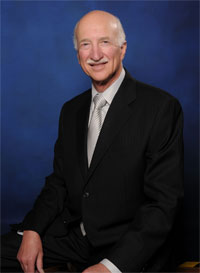 Education and Training
Education and Training
Dr. Kabaker received his medical degree from the University of Illinois College of Medicine in 1964. He underwent his internship at Letterman General Hospital in San Francisco as a captain in the U.S. Army Medical Corps and subsequently saw active duty in Vietnam. He continued his surgical training at the University Hospital in Cleveland, the Hines VA Hospital in Illinois, and the Los Angeles County USC Medical Center. After this period of extensive postgraduate training, he spent fellowship time in facial plastic surgery, studying under Dr. Richard Webster of Boston, MA, a renowned plastic surgeon.
While maintaining a private plastic surgery practice in San Francisco, Calif., Dr. Kabaker has averaged six weeks of continuing medical education annually since 1971. He has studied and taught facial plastic surgery in France, Spain, Italy, Germany, Israel , Mexico, Argentina ,the UK and Australia.
Dr. Kabaker has written chapters in textbooks and articles in medical journals on plastic surgery. He also lectures internationally to medical groups and has taught courses on hair replacement surgery since 1976. Dr. Kabaker has the longest ongoing experience in the U.S. with the Juri flap operation and has introduced the Juri flap and scalp expansion operations to many notable hair transplant surgeons. His most recent work ( 2010) was a chapter on scalp flap surgery and hairline advancement for Unger and Shapiro’s 5th edithion of “Hair Transplantation”
Certification
Dr. Kabaker has met rigorous requirements to become Board Certified by the American Board of Otolaryngology and the American Board of Facial Plastic and Reconstructive Surgery. He is a Diplomate of the American Board of Cosmetic Surgery making him one of only a handful of facial surgeons in the country to hold these multiple credentials.
Professional Appointments
Dr. Kabaker holds the position of Clinical Professor at the University of California-San Francisco School of Medicine, Department of Otolaryngology, where he has served as a consultant in the Division of Facial Plastic Surgery since 1974.
He has served on the boards of directors of the American Hair Loss Council, the Foundation for Facial Plastic Surgery, and the American Academy of Facial Plastic and Reconstructive Surgery (AAFPRS). He was also on the founding board of the International Society of Hair Restoration Surgery (ISHRS) and was the 6th president of the ISHRS (Oct. ’98-Oct. ’99).
Read Dr. Kabaker’s curriculum vitae here.
I have performed over 2,000 nasal surgeries dealing with almost all types of noses. I was the first surgeon to routinely perform open (external) rhinoplasty in California (1981) introducing the technique to prominent nationally recognized experts . As one of the more surgeon rhinoplasty surgeons in the Bay Area, I also continue to perform closed rhinoplasty on the appropriate nose. Most younger surgeons are not familiar with the closed approach which is usually quicker to perform and can be less traumatic than the open technique.
I perform a full range of facial rejuvenation procedures having been amongst those who pioneered the short flap, minimally invasive face lift introduced to me by Dr. Richard Webster in 1973. This operation, which now goes by all kinds of commercial names by many practitioners and groups, remains the mainstay of my facial rejuvenation philosophy. Eyelid lifts, forehead/brow lifts, neck lifts and chin augmentations are often performed with the basic cheek-neck lift. There are many variations on the theme along with other ancillary procedures Such as deep skin resurfacing) that vary with the needs of a particular patient. Facial fillers, microdermabrasion and Botox Cosmetic are provided in our facility but in my opinion are no substitute for a facelift. They serve the purpose of correcting those things that surgery does not correct and are no substitutes for surgery.
No more than a handful of surgeons in the world can claim an equivalent breadth of experience I have had in hair restoration surgery. My experience goes from plug grafts to flaps to scalp reductions to expansion and extension, to mini grafts and micro grafts, and now, for the past 14 years, follicular unit grafting. The hairline lowering operation I often perform evolved out of the flap and scalp reduction experience. The experience I have had with all of these modalities has allowed me to exercise a broad range of judgment as to what might work for you as the individual patient.
Please note: Dr. Kabaker has been the choice of many plastic and cosmetic surgeons to perform their personal hair transplantation. There have been over 25 such cases from the local area plus at least 100 physician and dentist patients.
Hairline Lowering/Forehead Reduction Surgery
My background in facial plastic surgery and hair restoration surgery puts me in a unique position in regard to doing this procedure, usually performed on women. I will make a claim, and leave others to contest it, that I have the greatest experience with the procedure of lowering the female hairline with a direct surgical advancement procedure. (Please see section on hairline lowering/forehead reduction.) I have performed hundreds of these procedures and find quite a bit of variation from person to person in their anatomy and desires, and therefore each operation involves individual planning and variation in the exact technique. I recently, for educational purposes, made three videos of this procedure. As I examine them and study them, I find that these were three significantly different operations to accomplish the same goal. Therefore, if you are considering this hairline lowering procedure, I cannot state the exact plan without seeing, examining, and talking to you. Each operation I perform is quite individualized in its planning and execution.
Through the Internet, we can get a good idea of what we might want to do and I have a routine of exchanging information and having telephone consultations before being seen and potentially scheduled for surgery. The majority of my patients for this operation come far from the San Francisco Bay Area and we have to take this into consideration. More questions? Click Here.